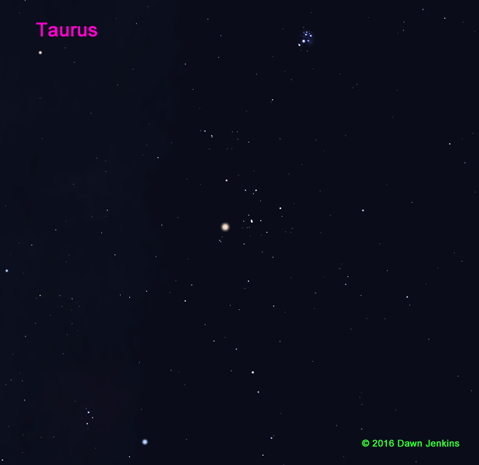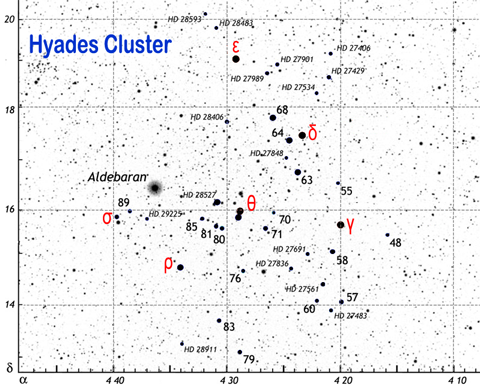
February 2019 - Vol. 23, No. 2
This Month's Night Sky - NOTE: The next paragraph describes the sky as it appears at 10 pm EST (11 pm EDT) near mid- month. The sky also looks this way at 11 pm EST (midnight EDT) during the beginning of the month and at 9 pm EST (10 pm EDT) by month's end.
The "Winter Triangle" asterism shines high overhead. It appears as an inverted triangle formed by three bright stars: Sirius (Canis Major) below, reddish Betelgeuse (Orion) upper right, and Procyon (Canis Minor). Betelgeuse is also the upper left member of my favorite asterism, hour-glass shaped Orion. If you have a clear sky, look for a hazy patch of light below Orion's middle "belt" star. That is M42, the Great Orion Nebula, the site of intense star formation. (At least it was some 1,600 years ago since it took that long for the light to reach you!) Other bright stars of interest are Rigel, the bottom left star in Orion, Aldebaran (Taurus) in the SW, Castor and Pollux (the Gemini twins) high above the winter triangle and orangish Arcturus (Bootes)right on the E horizon. The "Big Dipper" of Ursa Major stands majestically high in the N.
MERCURY will be visible in the evening sky this month, its position somewhat favoring northern observers. VENUS shines in the morning twilight sky favoring observers in the the southern hemisphere. MARS at magnitude +1 at 7.4" in diameter, moving from Aries into Taurus this month. JUPITER in the morning twilight will spend this year in the constellation Ophiuchus. SATURN in Sagittarius will be in the morning sky. URANUS sets before midnight.
Review how to determine Angular Measurement.
Calendar of Events
NOTE: For those observers not in the ET zone, convert the calendar times to your zone's time by subtracting one hour for CT, two for MT and three for PT. Don't forget to adjust for Daylight Savings Time when necessary by subtracting one hour from your planisphere's time. Dawn and dusk times must also be corrected. See your local newspaper, TV news, or cable TV's Weather Channel for sunrise and sunset times or check with the U.S. Naval observatory. Unfortunately some of these events may occur during daylight hours in your area.
| DATE | EVENT |
| 02 | Saturn 0.6 deg. S. of Moon occultation from northern Africa, S. and Cen. Europe, Middle East, W. Asia, parts of S Russia. |
| 05 | Moon at apogee. |
| 06 | Vesta 1.1 deg. S of Moon occultation from Micronesia, Hawaii, Aleutian Is., W. and Cen. N. America except Alaska. |
| 07 | Neptune 3 deg. N. of Moon. |
| 10 |
Mars 6 deg N. of Moon. Uranus 5 deg. N. of Moon. |
| 13 | Mars 1.1 deg. N. of Uranus. |
| 14 | Aldebaran 1.7 deg. S. of Moon. |
| 18 |
Moon 0.6 deg. S. of Beehive cluster (M-44). Venus 1.1 deg. N. of Saturn. |
| 19 | Moon at perigee, expect large tides. |
| 21 | Look W from a dark location, at about an hour after sunset, to view zodiacal light. ("Zodiacal light" is a vertical band of white light believed to be sunlight reflected from meteoroids found in the plane of the ecliptic, the apparent "path" of the Sun, Moon and Planets as they travel across our sky.) It will appear to be a very large, but very dim, pyramid of white light, "leaning" to the left. This effect may be visible for the next two weeks on dark nights. |
| 27 | Jupiter 2 deg. S. of Moon. Mercury greatest elongation E. (18 deg.) |
Lunar Almanac for February 2019
| Phases of the Moon | Phase and Date(s) | Best viewed before local midnight |
 |
New 04 |
Deep Space Objects |
 |
1st. Qtr 12 |
Planets & Moon |
 |
Full 19 |
Moon |
 |
Last Qtr 26 |
Deep Space & Planets |
Topic of the month: Taurus
 In the north, the evening winter sky sparkles, boasting of the brightest star as seen from Earth, the dog star Sirius and the giant hunter, Orion. They rule the sky with the bright stars and the twin constellation of Gemini. But they are are led across the night sky by the more northerly constellation of Taurus, the ecliptic constellation that has been associated with a bull. The bull is rather ignomatic to some, for although constellation maps may show horns, it is difficult to see more than one leg on the bull as it charges across the sky. The first magnitude star Aldebaran marks the eye of the bull, nestled in a triangular shaped group of stars that forms the "face" of the bull. The triangular face of the bull is a very important star cluster, the Hyades. The center of this cluster has been measured by astronomers to be located about 150 light years away from the Earth. The fiery eye of Aldebaran is not a member of the cluster, but resides about midway between our Sun and the Hyades center.
In the north, the evening winter sky sparkles, boasting of the brightest star as seen from Earth, the dog star Sirius and the giant hunter, Orion. They rule the sky with the bright stars and the twin constellation of Gemini. But they are are led across the night sky by the more northerly constellation of Taurus, the ecliptic constellation that has been associated with a bull. The bull is rather ignomatic to some, for although constellation maps may show horns, it is difficult to see more than one leg on the bull as it charges across the sky. The first magnitude star Aldebaran marks the eye of the bull, nestled in a triangular shaped group of stars that forms the "face" of the bull. The triangular face of the bull is a very important star cluster, the Hyades. The center of this cluster has been measured by astronomers to be located about 150 light years away from the Earth. The fiery eye of Aldebaran is not a member of the cluster, but resides about midway between our Sun and the Hyades center.
The Hyades cluster is nearby as clusters go, only the Ursa Major Star cluster is closer to us. The cluster was noted by ancient astronomers and was thought by some to indicate rain. It may be that when the cluster was prominent in the sky many locations on Earth experienced their "rainy" season. At least 10 stars in the cluster are fourth magnitude or brighter, with four of the brightest being well studied red giants. The brightest Hyades is the red giant Theta-2 Tauri, a spectroscopic binary. It forms a pair with Theta-1, a pleasure to observe with the naked eye, however the two stars are actually 4 light years apart and are not a true double star. The cluster is believed to be about 400 million years old based on star types of its members. The cluster may well appear best as a binocular object, contains no nebulousity and covers about 4.25 degrees of the sky.
The Hyades cluster is very important to astronomers because the proper motion of each individual star can be measured. Stars at the center of the cluster are moving at .11" annually, but outlying members show a more or less motion based on their position in the cluster. This means that the cluster itself is useful for establishing the size of the universe. The chart below shows the Henry Draper designations of the brightest members of the group except for the bright ones that have greek designations. The scale along the bottom is the right ascension and the vertical axis shows the declination. The bright star Aldebaran is the only non-member in this chart that has been labeled. This chart was originally created by Thuvan Dihn and licensed as stated below..

The Hyades will set around 2 am this month. They rise and set with the bright star Aldebaran and reside on the ecliptic opposite their famous half-sister, the Pleiades cluster. These two star clusters are among the finest in the night sky.
--See You Under the Stars!
Astra for Astra's Almanac
The Hyades star map was created by Thuvan Dihn and posted thanks to Wikimedia Commons. Find the file here!
This installment of "What's Up?" is ©2019 by Dawn Jenkins for Astra's Stargate. View Ron Leeseburg's Farewell Issue for information on where to find information such as is presented in this almanac.